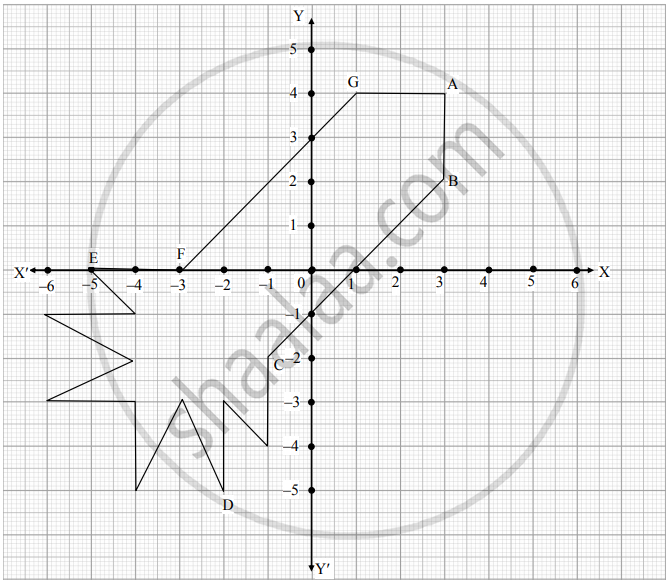Advertisements
Advertisements
प्रश्न
If three points (x1, y1) (x2, y2), (x3, y3) lie on the same line, prove that \[\frac{y_2 - y_3}{x_2 x_3} + \frac{y_3 - y_1}{x_3 x_1} + \frac{y_1 - y_2}{x_1 x_2} = 0\]
उत्तर
GIVEN: If three points (x1, y1) (x2, y2) and (x3, y3) lie on the same line
TO PROVE: \[\frac{y_2 - y_3}{x_2 x_3} + \frac{y_3 - y_1}{x_3 x_1} + \frac{y_1 - y_2}{x_1 x_2} = 0\]
PROOF:
We know that three points (x1, y1) (x2, y2) and (x3, y3) are collinear if
`x_1 (y_2 - y_3) + x_2 (y_3 - y_1) + x_3 (y_1 - y_2 ) = 0`
⇒ `x_1 (y_2 - y_3) + x_2 (y_3 - y_1) + x_3 (y_1 - y_2 ) = 0`
Dividing by `x_1 x_2 x_3`
⇒ \[\frac{x_1 (y_2 - y_3 ) }{x_1 x_2 x_3} + \frac{x_2 (y_3 - y_1 ) }{x_1x_2 x_3} + \frac{x_3 ( y_1 - y_2 ) }{x_1 x_2 x_3} = 0\]
⇒ \[\frac{(y_2 - y_3)}{x_2 x_3} + \frac{(y_3 - y_1)}{x_3 x_1} + \frac{(y_1 - y_2)}{x_1 x_2} = 0\]
Hence proved.
APPEARS IN
संबंधित प्रश्न
Find the coordinates of the circumcentre of the triangle whose vertices are (3, 0), (-1, -6) and (4, -1). Also, find its circumradius.
The points (3, -4) and (-6, 2) are the extremities of a diagonal of a parallelogram. If the third vertex is (-1, -3). Find the coordinates of the fourth vertex.
Prove that (4, 3), (6, 4) (5, 6) and (3, 5) are the angular points of a square.
Find the coordinates of the points which divide the line segment joining the points (-4, 0) and (0, 6) in four equal parts.
If the point P (2,2) is equidistant from the points A ( -2,K ) and B( -2K , -3) , find k. Also, find the length of AP.
If (2, p) is the midpoint of the line segment joining the points A(6, -5) and B(-2,11) find the value of p.
Find the ratio in which the line segment joining the points A(3, 8) and B(–9, 3) is divided by the Y– axis.
Prove hat the points A (2, 3) B(−2,2) C(−1,−2), and D(3, −1) are the vertices of a square ABCD.
If P ( 9a -2 , - b) divides the line segment joining A (3a + 1 , - 3 ) and B (8a, 5) in the ratio 3 : 1 , find the values of a and b .
ABCD is a parallelogram with vertices \[A ( x_1 , y_1 ), B \left( x_2 , y_2 \right), C ( x_3 , y_3 )\] . Find the coordinates of the fourth vertex D in terms of \[x_1 , x_2 , x_3 , y_1 , y_2 \text{ and } y_3\]
In \[∆\] ABC , the coordinates of vertex A are (0, - 1) and D (1,0) and E(0,10) respectively the mid-points of the sides AB and AC . If F is the mid-points of the side BC , find the area of \[∆\] DEF.
Write the coordinates the reflections of points (3, 5) in X and Y -axes.
Find the value of a so that the point (3, a) lies on the line represented by 2x − 3y + 5 = 0
If P (2, 6) is the mid-point of the line segment joining A(6, 5) and B(4, y), find y.
f the coordinates of one end of a diameter of a circle are (2, 3) and the coordinates of its centre are (−2, 5), then the coordinates of the other end of the diameter are
The line segment joining the points A(2, 1) and B (5, - 8) is trisected at the points P and Q such that P is nearer to A. If P also lies on the line given by 2x - y + k= 0 find the value of k.
Signs of the abscissa and ordinate of a point in the second quadrant are respectively.
Ryan, from a very young age, was fascinated by the twinkling of stars and the vastness of space. He always dreamt of becoming an astronaut one day. So, he started to sketch his own rocket designs on the graph sheet. One such design is given below :

Based on the above, answer the following questions:
i. Find the mid-point of the segment joining F and G. (1)
ii. a. What is the distance between the points A and C? (2)
OR
b. Find the coordinates of the points which divides the line segment joining the points A and B in the ratio 1 : 3 internally. (2)
iii. What are the coordinates of the point D? (1)
